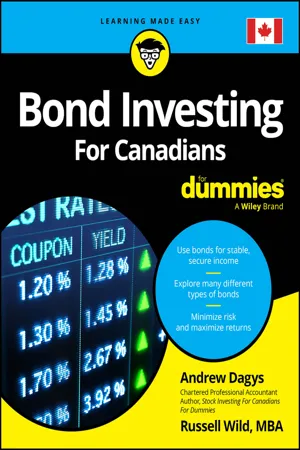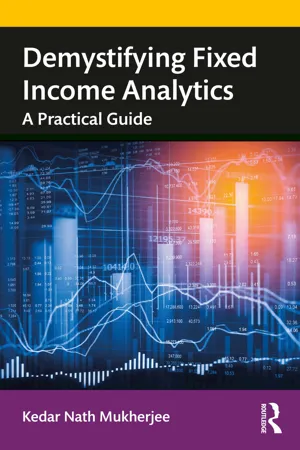Business
Bond Returns
Bond returns refer to the profit or loss an investor realizes from holding a bond over a specific period. They are influenced by factors such as the bond's coupon rate, market interest rates, and the bond's price fluctuations. Bond returns can be calculated as the sum of interest payments received and any capital gains or losses upon the bond's sale.
Written by Perlego with AI-assistance
Related key terms
1 of 5
6 Key excerpts on "Bond Returns"
- eBook - ePub
- Ian Davidson, Mark Tippett(Authors)
- 2012(Publication Date)
- Routledge(Publisher)
1 The measurement of returns on bonds, equities and other financial instruments§1-1. The calculation and indeed, the manipulation of returns pervades our everyday lives. When one opens a bank account or line of credit with a financial institution, the rate of interest on surplus funds and/or the rate of interest on the overdraft facilities we expect to use figure highly in the decisions we make about which bank/and or financial institution we will lend our custom to. When it comes to risky assets such as the shares and bonds of publicly listed companies, we make investment decisions by weighing the returns we expect to get from our proposed investments against the risks that are likely to arise from them. Our retirement plans also hinge crucially on the returns earned by the superannuation funds with which we deposit our retirement funds and on the prospective benefits these returns will enable us to enjoy after we retire. All of this presupposes of course that we have a clear understanding of how the returns on a given portfolio or financial instrument ought to be calculated. Hence, the principal brief of this chapter is to identify the pitfalls that may arise from the incorrect calculation and averaging of the returns that accrue on shares, bonds, portfolios and other financial instruments. We begin our analysis with a consideration of the procedures that can be used to compute the returns on bonds.§1-2. A bond is a written contract by a debtor to pay a creditor a redemption payment V on an indicated date and to pay a pre-specified amount K (normally termed interest) on a periodic basis. The typical bond mentions a borrowed principal H, called the face value or par value of the bond. Bonds typically make interest payments on a semi-annual basis and are redeemable at par – in which case V = H. Consider, then, the purchaser of a bond who demands that his money be invested at a pre-specified rate r - eBook - ePub
- Erik Lie(Author)
- 2023(Publication Date)
- Business Expert Press(Publisher)
Figure 2.2 . Bonds get most of their return from distributions (i.e., interest payments), while stocks get most of their return from capital gains and only a modest return from distributions (i.e., dividends). Furthermore, the capital gains for bonds from issuance to maturity is set. Thus, Bond Returns are less volatile than stock returns. The next subsections discuss these issues in greater detail.Bonds and Bond ReturnsBonds are debt securities issued by the federal government (Treasury bills and bonds), state and local governments (municipal bonds, or munis), and corporations. You can readily buy individual Treasury bills and bonds. However, the markets for individual munis and corporate bonds are rather illiquid, making purchases expensive, just like buying foreign currency from a street vendor. Thus, if you wish to invest in bonds, you are likely better off buying some mutual fund or exchange-traded fund (ETF) that specializes in bonds, such as Vanguard’s total bond market ETF (with ticker symbol BND).Figure 2.3 Bond prices over timeMost bonds pay periodic interest payments, also called coupons, typically every 6 or 12 months. The primary return from buying bonds stems from these coupon payments. However, it is also possible for an investor who does not hold a bond from issuance to maturity to experience considerable capital gain or loss because bond prices fluctuate over time.This book will not cover bond valuation because there is no need for most individual investors to have that skill. Yet it is useful to know how bonds change in value between issuance and maturity.Figure 2.3 shows the price over time for two hypothetical bonds with the common par value of $1,000.1 There are several noteworthy aspects:1. The prices around the issuance are very close to the bond’s par value of $1,000.22. - eBook - PDF
- Andrew Dagys, Russell Wild(Authors)
- 2023(Publication Date)
- For Dummies(Publisher)
Return is the potential of making money. Most of the money made in bonds is made in the form of interest payments. Sometimes, bonds also appreciate (or, alas, depreciate) in value. Overall, the return potential of bonds is modest com- pared to certain other investments, such as an investment in the S&P/TSX 60 or a dry-cleaning franchise in the local strip mall. As we make clear, we hope, through- out this book, the benefit of bonds is more to temper risk and provide steady, predictable income than to capture huge gains. Appreciating Bonds’ Risk Characteristics In Chapter 9, we talk about bond derivatives, defaulted bonds, and a few other bond investments that most people would consider wild and crazy by fixed- income standards. But the majority of bond offerings are rather staid investments. You give your money to a government or corporation. You receive a steady flow of income, usually twice a year, for a certain number of years. Then, typically after a few years, you get your original money back. Sometimes you pay taxes. A broker usually takes a cut. Beginning and end of story. The reason for bonds’ staid status is not only that they provide steady and pre- dictable streams of income, but also that as a bondholder you have first dibs on the issuer’s money. A corporation is legally bound to pay you your interest before it doles out any dividends to people who own company stock. If a company starts to go through hard times, any proceeds from the business or (in the case of an actual bankruptcy) from the sale of assets go to you before they go to shareholders. However, bonds offer no ironclad guarantees. First dibs on the money aside, bonds are not CDIC- or FDIC-insured savings accounts. They’re not without some risk. 166 PART 3 Bonds as Portfolio Cement For that matter, even a CDIC-insured savings account at a chartered bank — even stuffing your money under the proverbial mattress — also carries some risk. Following are seven risks inherent in bond investing. - eBook - ePub
Demystifying Fixed Income Analytics
A Practical Guide
- Kedar Nath Mukherjee(Author)
- 2020(Publication Date)
- Routledge India(Publisher)
4 Risk and return measuresKey learning outcomesThis chapter is expected to enable readers to answer the following questions:- What are the different types of risk associated with investment in fixed income securities?
- How to capture risks in individual debt security and the portfolio.
- What are the different measures to calculate returns from investment in debt instruments?
- How to estimate security-wise and portfolio level returns.
- What are the major advantages and limitations of various risk-return measures?
Risk and return in bonds: meaning and linkagesBonds are an important component of investment portfolios for most investors, especially for institutional investors. Bonds reduce the overall risk of a portfolio by introducing diversity. Bonds produce steady current income – income that investors receive, say in every year/six months/quarter. This steady stream of income is important to some investors, depending on their asset-liability structure and their current needs. Bonds are more low-risk investments than stocks, sometimes at the cost of lower returns. The attractiveness of bond investment largely depends upon the future movement of interest rates. Bonds are attractive options when the market anticipates interest rates to fall. As interest rates fall, bond values rise, giving a positive return to the investor. The main sources of return from a bond are: regular (annual/semi-annual) coupon income, reinvestment income (i.e. interest on coupon received), and bond’s price appreciation (if any). Even if the coupon rate, the major source of return from a bond, is fixed in a fixed rate bond, there may be several risk factors causing different levels of variation in the returns from a bond. Alternatively, bonds are susceptible to a number of risks, depending on the nature of the bond issue. Like other investment opportunities in the financial market, the risk-return linkage is also applicable in a bond investment. If an investor wants to earn a higher return, he has to compromise with some risk factor(s), such as credit risk, interest rate risk, liquidity risk, etc. There can be different measures available to capture the risk and return from an individual security, or a portfolio of many securities. These are discussed in the following section. - eBook - PDF
Triumph of the Optimists
101 Years of Global Investment Returns
- Elroy Dimson, Paul Marsh, Mike Staunton(Authors)
- 2009(Publication Date)
- Princeton University Press(Publisher)
In many countries, the size of the bond markets and the volume of trading in bonds exceed those of equities. This is not a new phenomenon. Even at the start of the twentieth century, bonds seemed a natural, and often the preferred, investment for individuals and financial institutions. But sadly, the twentieth century turned out to be a far from benign period for bond investors. Our focus is mostly on long-term government bonds. These form a key segment of all national and international bond markets, and set the benchmark rates for all other debt instruments. Government bonds, unlike corporates, are normally free of default risk, at least in developed markets. They offer known payoffs, and for an investor who holds a bond to its maturity date, the yield is known in advance, and is thus risk free, at least in nominal terms. Bond Returns are not only important in their own right, but also because they are often used as a benchmark in computing the equity risk premium. But while government bonds are generally default free, they are not “risk free.” For although investors know for sure how many dollars they will receive in the future, they do not know their purchasing power. Despite this, we follow common practice when we calculate the equity risk premium relative to bonds as well as bills (for example, in chapter 12). This premium is clearly of interest— whether viewed as a true risk premium or not—since it compares returns on the two most important asset classes available to investors. In examining Bond Returns, we look first in section 6.1 at the US experience from 1900–2000, comparing it with the United Kingdom. In particular, we focus on real returns earned by bond investors, and on the progress of long bond yields during the twentieth century. In section 6.2, we compare Bond Returns across all sixteen countries. - eBook - PDF
Corporate Finance
Theory and Practice in Emerging Economies
- Sunil Mahajan(Author)
- 2020(Publication Date)
- Cambridge University Press(Publisher)
Investment Risk We have defined risk as the possibility of more than one outcome for any action we take. More varied the outcomes, greater is the risk. Similarly, investment risk refers to more than one possible return on an investment. Greater the spread of returns, higher is the risk. On the other hand, if the possible returns are more closely bunched around the average, the risk is low. 134 | Corporate Finance Let us look at the impact of risk on investment decisions. You have a few rupees saved and your thoughts obviously turn to government bonds since they are considered to be a safe security. With its ability to raise taxes and print currency, the government is not expected to default on its obligations. (It is another matter that despite being free of any possibility of default, even government bonds carry risk—price risk and the risk of reinvestment). Currently, government bonds yield 7 per cent. Adjusted for an expected inflation of 5 per cent, this does not leave much in terms of real return for the investors. You learn that corporate bonds provide a return which is higher than the return on government bonds. You look up the credit rating of different companies and decide to play it safe by investing in bonds issued by Rural Electrification Ltd with an AAA rating, implying the highest possible safety. Instead of the 7 per cent returns provided by the government bonds, you are now able to obtain 200 basis points higher at 9 per cent. This whets your appetite for more and you do not mind taking a little higher risk by investing in bonds of Rama Shyam Papers Ltd, with a BB rating. The return available now is 13 per cent. As you take a greater risk, the returns are usually higher. Finally, you decide to test the stock markets, exposing your investment to even higher risk. Stocks in India have yielded a little over 15 per cent per annum between 30 March 2002 and 31 March 2017.
Index pages curate the most relevant extracts from our library of academic textbooks. They’ve been created using an in-house natural language model (NLM), each adding context and meaning to key research topics.





